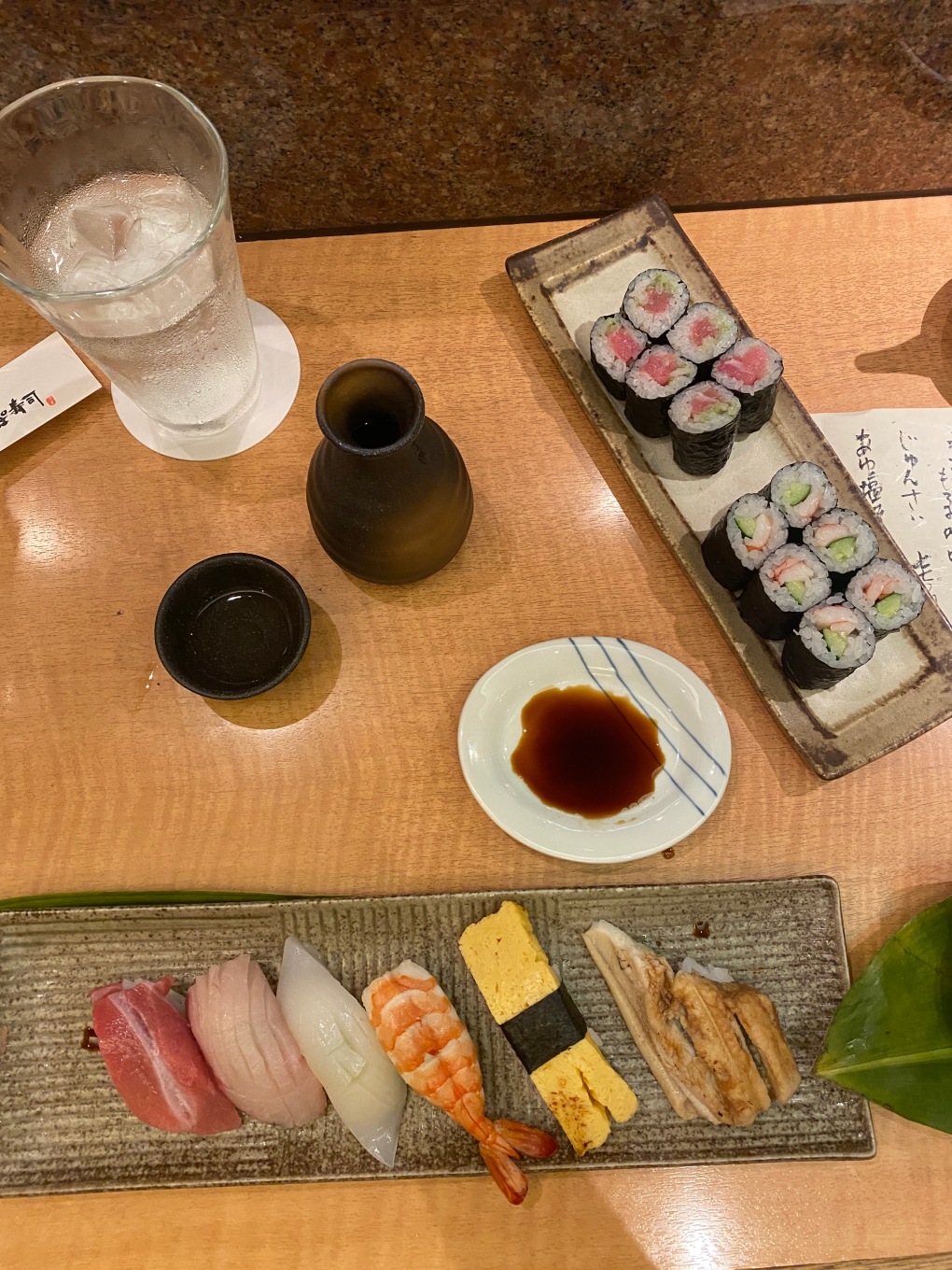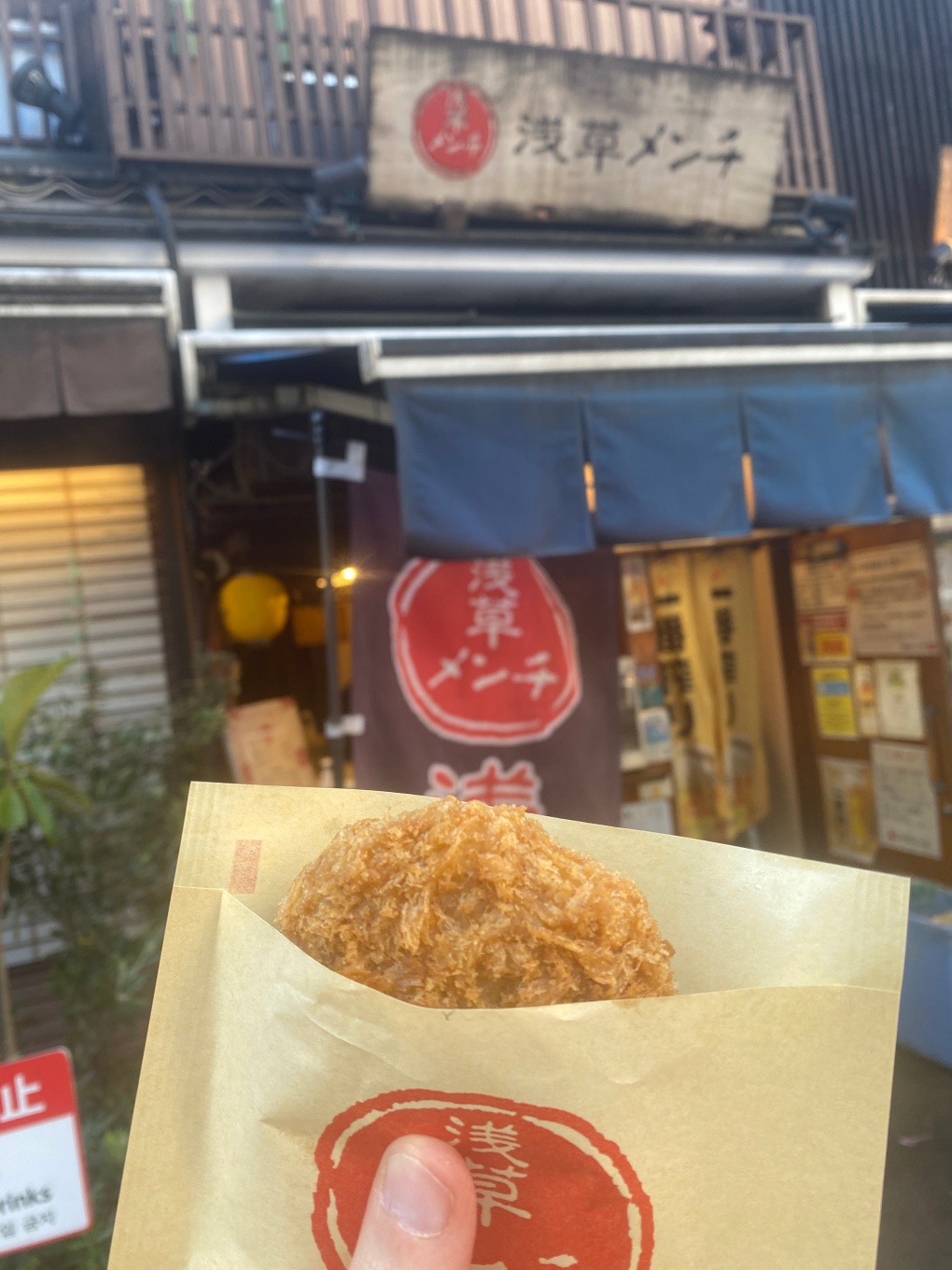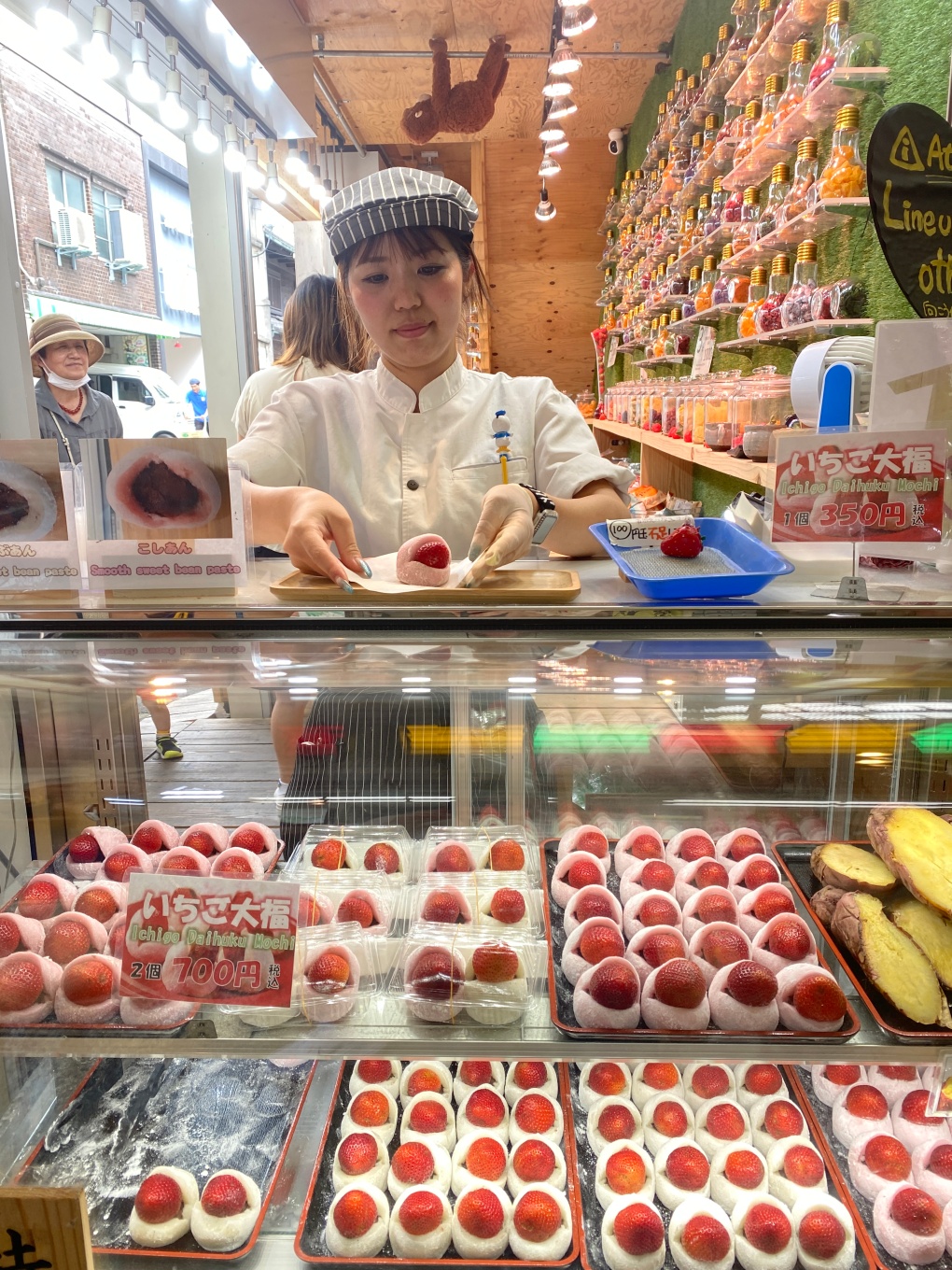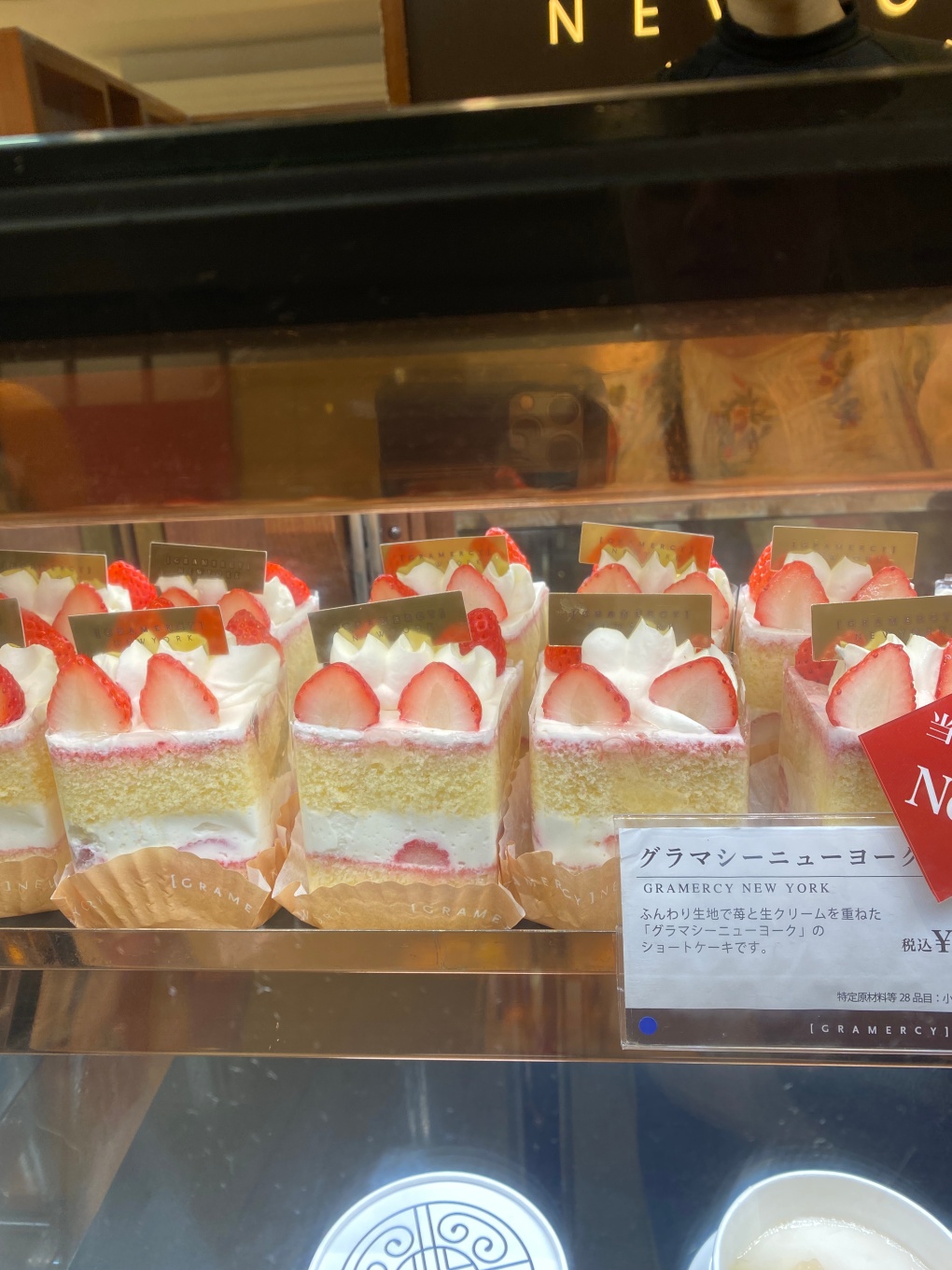I had been told for years that eating out in Japan was really expensive, so I was pleasantly surprised to find that this was not really the case at all. Let me be totally transparent here though. I was not eating out at Michelin starred restaurants, instead opting to mainly dine in the type of eating establishments that regular Japanese folks eat at. This involves queuing for a table and not lingering over the meal. You eat and go. On a couple of occasions we chanced our luck by turning up at a couple of restaurants recommended in our guide book. Big mistake as we were turned away both times, one we had needed to book 3 months advance (the guidebook didn’t mention that part unfortunately).
The sushi restaurant we went to in Kyoto – Pontocho Kappa Zushi, (160 Matsumotocho, Nakagyo-ku) our ryokan kindly helped secure the table, which can be tricky at short notice, so I guess we lucked out in that instance. Sushi restaurants tend to be more expensive than your average restaurant, which is understandable looking at the product it is selling – namely fish – and whilst you can eat at ones which are £100-200 a head, the one above came to not much more than £20 a head for a tasty sushi experience that was freshly prepared before you as you sat at the counter.
At many restaurants the dishes within are presented in the window for customers to see what they are getting, which is really helpful. The food looks so life like (see photo above), but in fact is made of plastic or wax and made to emulate the texture, form and look of the meals. The term for this ‘fake food’ is ‘shokuhin sampuru’ 食品サンプル. It is a huge industry in Japan.
Most places you eat at – including street food, you need to queue, but whilst the length of them can sometimes look intimidating they tend to move relatively quickly. Equally you can aim to eat early to miss the rush of lunch/supper diners.
In Tokyo, one evening we headed to atmostpheric Omoide Yokocho area (‘yokocho’ loosly translates as ‘nostalgia’), which is in stark contrast to the futuristic Shinjuku neighbourhood that it is nestled in. It’s a rabbit warren of narrow alleyways crammed with eateries seating no more than 10 diners around a small bar serving ramen, sushi and yakitori.
Paper lanterns hang overhead as steam and smoke wafts from the open kitchens. It is reminiscence of an old Japan, a bygone age, that is only just clinging on as the high rises climb ever further towards the nights sky.
We sat and dined at the Izakaya (above). They are similar to a European tavern or pub, but instead you all sit at a bar and face the kitchen. Everything was in Japanese so I just pointed to what my neighbour was having and said I’d have the same. Before long my neighbour was ordering extra food for us to try and we were conversing via our my portable translator I’d rented for the trip. It was fun and atmospheric and definitely hit the spot after a days sightseeing and being on our feet. Below are silken chilled tofu (perfect in the sweltering heat of summer) with bonito flakes, wood ear mushroom mixed veg medley and gyoza – oh and a chilled cold beer!
At some restaurants (the one below), you have to put your order into a machine instead of giving it to a human. At first it seems a little intimidating, especially if others are waiting, but it doesn’t take long to get the hang of it. For the whole trip I was determined to find a great place to eat katsu curry. Katsu curry is one of my childhood memory foods -click here to find out why. In Osaka, we headed to Oretachino No Curry Ya (14-13 Nanbasennichimae, Chuo Ward) that had come highly recommended.
We arrived early and were first in the restaurant as luck would have it – I think it was around 5.30pm. Not long after we were seated, others joined and before long the whole restaurant was full – it only sits around 12 people.
For the katsu option (you could also have ramen here) you choose between pork or chicken and a whole range for toppings. I opted for the chicken with a flurry of spring onion topping that did not disappoint.
Street food was plentiful and varied and each day we tried all manner of interesting looking delights. Near to our hotel in Tokyo was the tastiest deep fried pork mince and onion cutlet, I have ever eaten. Juicy and succulent, they oozed with deliciousness from the first bite. Head to Asakusa Menchi – 2 Chome-3-3 Asakusa, Taito City, Tokyo they are open from 10am-7pm.
You’ll find it easily as everyone makes a bee line to this place. I popped a short reel on instagram about them and bizarrely it reached almost 50k views which baffles me if I’m honest as it was such a quick unedited reel – go take a look if you are on instagram.
When it came to sweet treats my favourite street food was Taiyaki (鯛焼き, lit. ‘baked sea bream’) a Japanese fish-shaped cake, that imitates the shape of tai (鯛, red sea bream), which it is named after. They are filled with either pipping hot custard, red bean paste made from sweetened adzuki beans, chocolate, cheese or sweet potato.
I discovered I loved the texture of mochi pronouced (Moechee). It is Japanese dessert crafted from sugary glutinous rice flour. It is very chewwwwwwwy and squishy and probably best not eaten in one go. It comes in so many forms and flavours. Also known as Daifuku (大福餅) it can be plain or stuffed with red or white bean paste. Strawberry mochi were ever so delicious.
Mealtimes in the temple lodgings in the mountain town of Koyasan were a highlight of the trip. I can’t honestly tell you what we ate exactly, as I am not too sure myself, but each little bowl contained artistically arranged food that was almost too beautiful to eat. We sat on the tatami floor and small tables were brought in and placed in front of us. Miso soup, tempura and rice were always served and each meal varied from the last.
The monks provided us with breakfast and supper and during the day we ate a light snack, followed of course, by an ice cream to cool us down.
Black sesame for me and macha for my daughter.
Another tip when travelling around Japan is to consider eating food either in, or having take-out, from the large department stores food halls. One evening we decided to eat in our hotel room and bought all manner of goodies from the food hall of Takashimaya in Kyoto. Think Harrods Food Hall vibes – although on a slightly smaller scale, but you get the gist. If you go in the last hour before closing time all the food is massively marked down.
Yes we did get some of this tasty strawberry cake below.
In Tokyo the place to head is Mitsukoshi .
I’m conscious that this post is becoming rather long, and I’m guessing few will get this far, so I will hold off mentioning a few other places just now and will absorb them in my future posts about Japan.
I will leave you with this Japanese proverb (a proverb in Japanese is called Kotowaza) to ponder.
“Eat it raw before all else, then grill it, and boil it last of all.”
Translation: Let no aspect of Japanese cuisine get overlooked. Consider everything – flavours, textures, colours, overall composition and presentation.
…..until the next instalment





















6 thoughts on “Eating out in Japan”